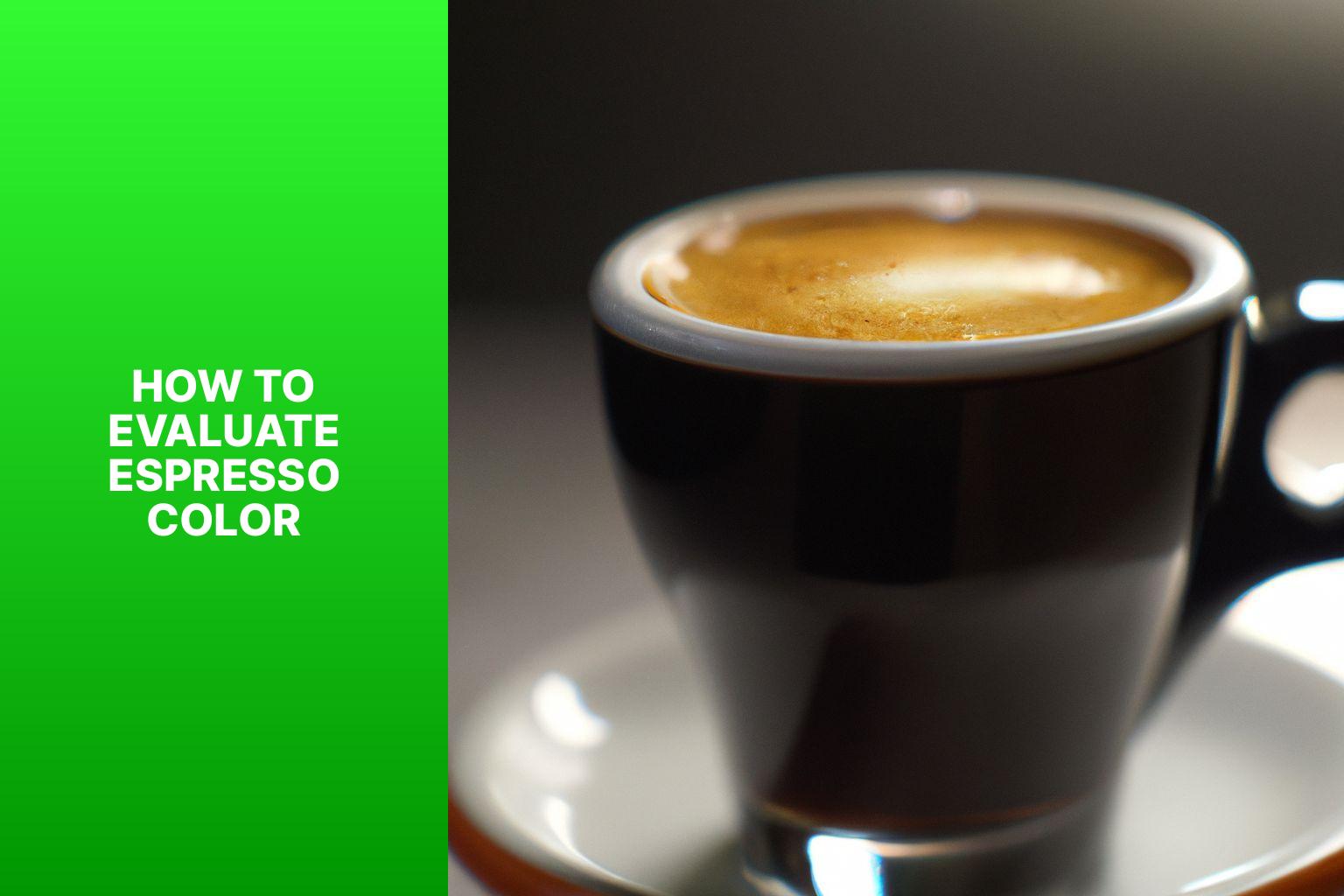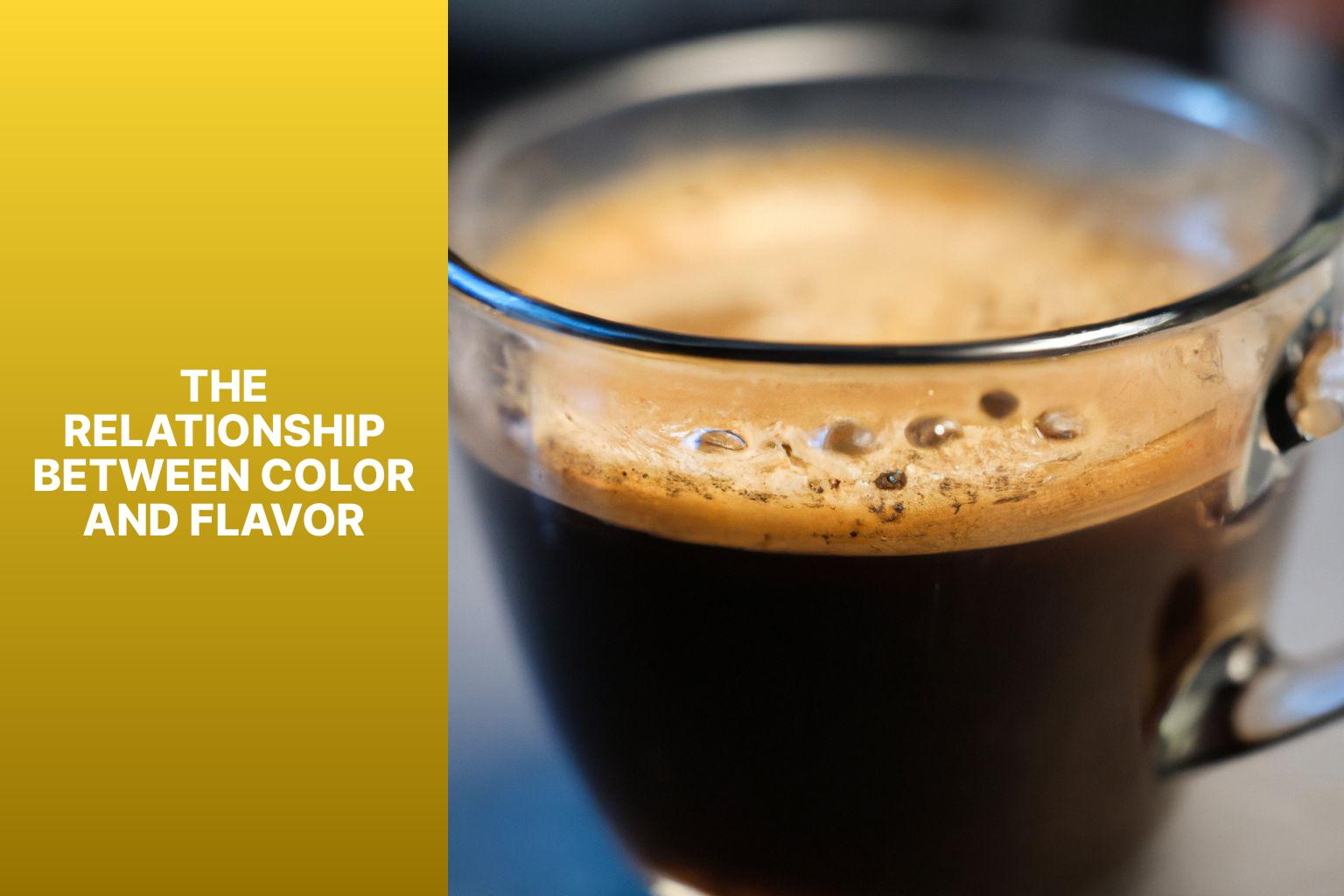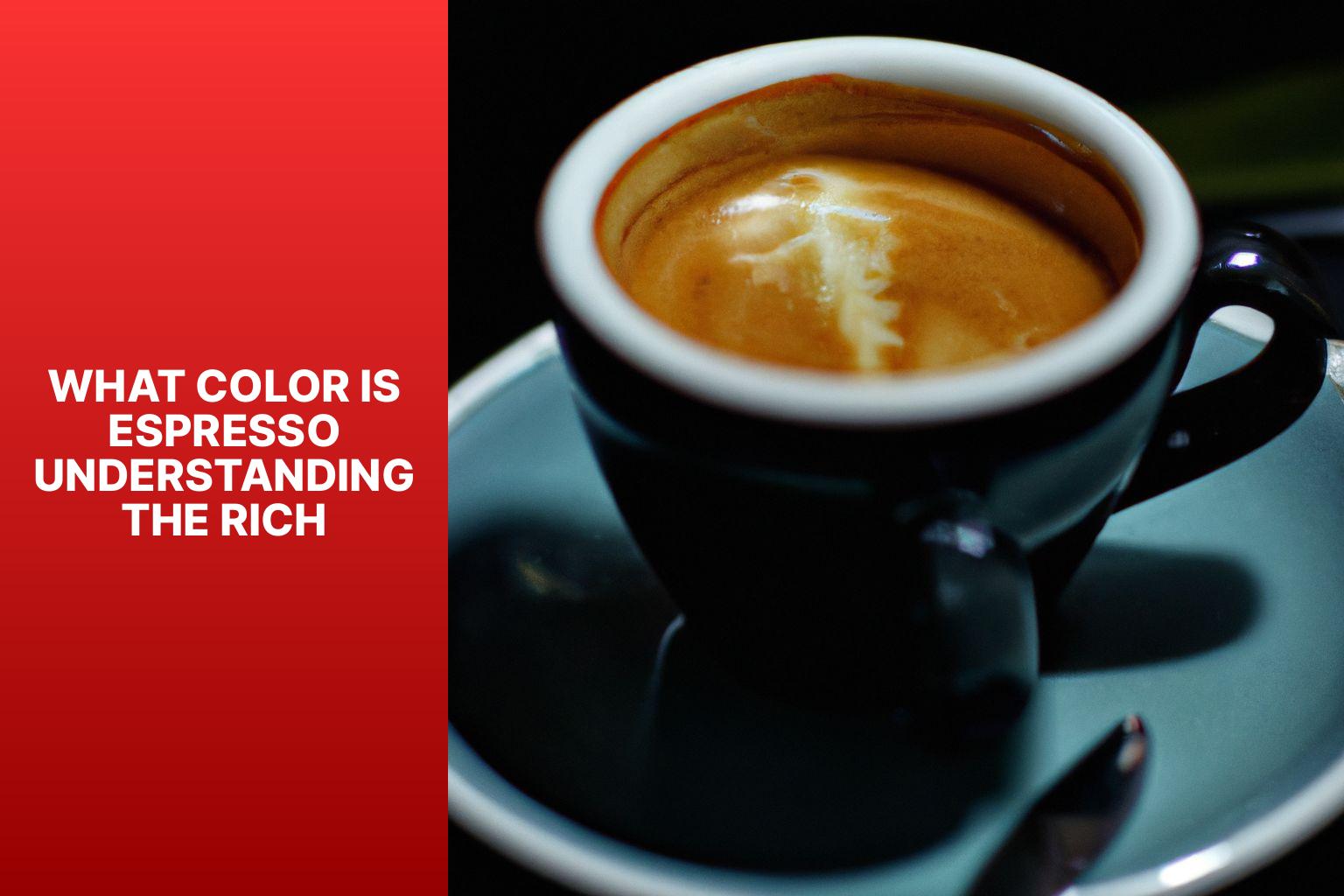Espresso, a concentrated form of coffee known for its rich flavor and aroma, is a beloved beverage enjoyed by coffee enthusiasts worldwide. While its taste is often the highlight of discussion, the color of espresso also holds significance in understanding its characteristics. In this article, we will delve into the various aspects of espresso color, its tones, and what they represent.
Espresso typically exhibits a dark brown hue, but it encompasses a range of tones that contribute to its visual appeal. Through a closer examination, one can identify the presence of red undertones and even blackish-green shades, which add depth and complexity to the overall color profile.
Understanding the importance of color in espresso is crucial, as it gives insights into the brewing process and helps assess the quality and roasting level of the coffee beans. Several factors influence the color of espresso, including the roasting level, the origin and quality of the beans, and the brewing method employed.
Evaluating espresso color can be done through different methods, from observing the visual appearance with the naked eye to utilizing color meter devices that provide precise measurements. Both approaches contribute to a comprehensive understanding of the coffee’s color profile.
There exists a close relationship between color and flavor in espresso. Lighter and darker espresso variations exhibit distinct taste differences, with lighter roasts often characterized by brighter and more acidic flavors, while darker roasts tend to offer bolder and more robust flavor profiles.
By delving into the color nuances of espresso and understanding their significance, coffee lovers can enhance their appreciation of this beloved beverage. So, let’s dive into the world of espresso color and unravel the rich tones that contribute to the ultimate coffee experience.
What Color is Espresso?
Have you ever wondered what color espresso truly is? In this exploration, we’ll dive into the nuances of the dark brown hue, uncover the presence of red undertones, and even delve into the intriguing world of blackish-green shades. Get ready to see espresso in a whole new light as we explore its captivating colors and reveal the secrets behind this beloved coffee concoction.
Understanding the Dark Brown Hue
The appreciation of espresso’s concentrated coffee lies in understanding its dark brown hue. This dominant color gives espresso a refined look, resembling mahogany wood or dark chocolate, which exudes sophistication. The visual appeal of espresso is enhanced by this dark brown shade, making it a popular choice among interior designers and art enthusiasts.
Examining the dark brown hue of espresso entails considering its nature and any undertones. As a warm member of the brown color family, espresso exhibits a velvety brown hue. Occasionally, the dark brown hue of espresso may even possess reddish undertones, thereby adding complexity to its appearance.
To grasp the dark brown hue of espresso, one must delve into its brewing process and the coffee bean used. The finely ground beans utilized in espresso extraction contribute to its dark brown color, as does the Italian-style brewing method performed under pressure.
To fully appreciate and evaluate the dark brown hue of espresso, it is best to observe it with the naked eye or employ color meter devices for precise measurements. The color can vary depending on factors such as the level of roasting, the origin of the beans, and the brewing technique utilized.
The Presence of Red Undertones
Espresso possesses the presence of subtle and refined red undertones that inherently contribute to the depth and complexity of its dark brown color. These red undertones play a pivotal role in amplifying the warm and inviting ambiance associated with espresso, especially when combined with interior designs featuring dark colors. These undertones significantly enhance the full-bodied flavor of espresso, thereby infusing each sip with a delightful richness.
The red undertones, being delicate and sophisticated, imbue espresso with a visually pleasing velvety brown hue. This distinctive coloring has the potential to elevate various visual elements in art and design, bestowing them with an added dimension of richness and allure.
Exploring Blackish-Green Shades
Blackish-green shades in espresso add depth and visual appeal. Explore these shades through the table below:
| Shade Name | Color Description | % in Espresso Color |
| Blackish-Green | A dark hue with hints of green | Approximately 20% |
| Dark Brown | The dominant color with rich, moody characteristics | Approximately 60% |
| Reddish Undertones | Subtle red hues enhance complexity | Approximately 10% |
| Other Colors | Varying shades of brown | Approximately 10% |
Exploring blackish-green shades showcases the versatility and complexity of espresso. It adds an extra dimension to the brown hue, resulting in a full-bodied cup of coffee with harmonious flavors and visual allure.
Blackish-green shades elevate the visual experience of enjoying espresso. Green tones add uniqueness and sophistication, creating a refined look that enhances the atmosphere in coffee shops or at home.
These shades result from the brewing process. Finely ground beans undergo pressure and hot water extraction, bringing out rich flavors and colors. Blackish-green shades demonstrate skillful craftsmanship in Italian-style coffee making.
In interior design, blackish-green shades blend seamlessly with wooden floors, mahogany wood accents, or darker furniture tones. They provide visual appeal and create an inviting atmosphere for coffee lovers.
The Importance of Color in Espresso
Color is of utmost importance in espresso, as it plays a significant role in indicating its characteristics and qualities. There are several reasons why color holds such importance in espresso:
-
Visual appeal: The color of espresso contributes greatly to its presentation and overall visual appeal. A desirable espresso is characterized by a rich, dark brown color with a hint of caramel-like hue, which signifies a well-extracted brew.
-
Extraction quality: The color of espresso reflects the extraction process and provides valuable insights into the quality of the brew. If the color is too light, it indicates under-extraction, resulting in a weak and sour taste. On the other hand, an excessively dark color suggests over-extraction, leading to a bitter and burnt flavor.
-
Strength and concentration: The intensity of color in espresso gives us a glimpse into the strength and concentration of the brew. A deep and opaque color indicates a stronger espresso with a higher concentration of flavor compounds.
-
Crema formation: The crema, the foamy layer that sits atop the espresso, possesses a rich color and texture. Its color can range from a light golden shade to a deep reddish-brown, indicating the presence of oils and aromatic compounds released during the brewing process.
-
Brewing consistency: Monitoring the color of espresso helps in ensuring consistent taste and quality. Baristas rely on the color as a visual reference to adjust brewing parameters and achieve consistent results with each cup.
Understanding the significance of color in espresso enables coffee enthusiasts to appreciate the subtle nuances and unique characteristics of their favorite brew. It adds depth to the sensory experience and aids in crafting a meticulously prepared cup of espresso.
The Factors Affecting Espresso Color
Ever wondered what factors contribute to the beautiful color of your espresso? In this section, we’ll uncover the secrets behind the mesmerizing hues found in your cup of coffee. From the roasting level to the origin and quality of the beans, and even the brewing method used, each of these elements plays a vital role in determining the enticing shades of your espresso. Get ready to delve into the captivating world of espresso colors and discover how these factors intertwine to create your perfect cup.
Roasting Level
The Roasting Level of espresso determines its flavor and aroma.
Choosing the right roasting level for your espresso depends on your personal taste preferences. Experimenting with different roasts will help you discover the flavors and characteristics you enjoy the most.
Bean origin and quality: The backbone of your espresso’s flavor, proving once and for all that not all beans were created equal.
Bean Origin and Quality
The origin and quality of coffee beans have a significant impact on the flavor and aroma of espresso. Different regions produce beans with unique characteristics and taste profiles. For example, Colombian beans have bright acidity and caramel sweetness, while Ethiopian beans offer floral and fruity notes.
The quality of beans is crucial for a flavorful and well-balanced cup of espresso. Higher quality beans come from reputable farms, undergo careful selection and processing, and have fuller bodies with more distinct flavors.
When choosing beans for espresso, opt for freshly roasted beans from reliable sources. This ensures good quality and enhances the overall taste experience.
Suggestions:
- Try different origins for diverse flavor profiles
- Purchase freshly roasted beans from reputable sources
- Experiment with brewing methods and grind sizes for enhanced flavor
- Enjoy exploring the world of espresso through different bean origins and quality levels.
Brewing Method
The brewing method determines the color of espresso. It affects the extraction process and contributes to the rich tones and brown hue of espresso. Different brewing methods can result in variations in color due to factors like water temperature, brew time, and grind size.
To demonstrate the impact of brewing methods on espresso color, a table can be created:
| Brewing Method | Color of Espresso |
| Espresso Machine | Deep, dark brown with reddish undertones. |
| Moka Pot | Medium-dark brown with a reddish hue. |
| Aeropress | Lighter brown with a reddish undertone. |
| French Press | Medium brown with a rich tone. |
The brewing method also affects the taste and aroma profile of espresso. Each brewing method extracts flavors and oils from the ground beans differently, resulting in variations in flavor.
Understanding the impact of the brewing method on espresso color is crucial for coffee enthusiasts and baristas. It allows them to adjust brewing parameters to achieve the desired result and create a flavorful cup of espresso.
The naked eye is a reliable judge of espresso color, unless you’re an espresso colorblind unicorn.
How to Evaluate Espresso Color

Photo Credits: Theimperfectcafe.Com by Benjamin White
When it comes to evaluating the color of espresso, there are a couple of methods that can help. We’ll look at how to do this using our naked eye and explore the use of color meter devices. By understanding these approaches, we can gain valuable insights into the rich tones and visual characteristics of our beloved coffee. So, let’s dive in and uncover the secrets behind assessing the color of espresso!
Using the Naked Eye
Using the naked eye is the simplest and most common method to evaluate espresso color. By observing the brewed coffee’s appearance, important information about richness and intensity can be gathered. Espresso is a rich dark brown, which can vary based on roasting level, brewing method, and bean origin.
When using the naked eye, look for a velvety brown hue that is deep and full-bodied. The color should not be too light or too dark, rather it should be in the middle range of brown. Avoid reddish undertones or a black appearance, as they may indicate over or under-extraction. Reddish hues suggest longer extraction, while a blackish color suggests shorter extraction.
Using the naked eye lets you appreciate the captivating visual appeal of espresso and helps determine its quality and taste characteristics before taking a sip. It is an easy and convenient method that doesn’t require specialized equipment. By using the naked eye, you can judge the quality of your espresso and ensure it meets your preferences.
Get scientific with your espresso evaluation by using color meter devices, because your eyes can only judge a lot, but a device can measure the dot!
Using Color Meter Devices
Using color meter devices is a valuable tool in coffee-making. It enables baristas to create visually appealing espresso with consistent taste and quality. By using color meter devices, baristas and coffee enthusiasts can ensure consistency in the color of their espresso, making it easier to achieve the desired shade. These devices measure the color values of the espresso, providing numerical data for accurate measurement of espresso color.
The devices can detect subtle variations in hue, allowing for precise adjustments during brewing. This ensures precise adjustments during brewing, resulting in a consistently desired shade. The data obtained from color meter devices can be used to monitor the quality of the espresso over time. By comparing color measurements from different batches, baristas can identify any inconsistencies or deviations in the brewing process that may affect the taste and appearance of the final cup. This allows for monitoring quality over time, ensuring a high-quality espresso.
Examples of color meter devices include spectrophotometers, colorimeters, chromameters, and reflectance colorimeters. These devices provide accurate color measurements, allowing for reliable evaluation of espresso. Incorporating color meter devices into the coffee-making process is essential for achieving consistent results.
Using color meter devices is a reliable method for evaluating espresso. It provides accurate measurement of espresso color, consistency in achieving the desired shade, precise adjustments during brewing, and monitoring quality over time. Incorporating this method into the brewing process can enhance the overall coffee-making experience for both baristas and coffee drinkers.
The Relationship Between Color and Flavor

Photo Credits: Theimperfectcafe.Com by Bobby Hernandez
Unlock the secrets of your morning brew as we delve into the fascinating connection between color and flavor. Discover how the shade of your espresso can influence your taste experience. From the complex nuances of lighter espresso to the robust flavors of darker brews, we’ll explore the mouthwatering variations that color brings to your cup. Get ready to sip your way through a palette of flavors that will leave your taste buds craving more.
Lighter vs. Darker Espresso: Taste Differences
When it comes to espresso, the taste can be affected by the color. Here are some differences in taste between light and dark espresso:
– Lighter Espresso:
- Compared to darker espresso, it has a milder taste.
- It may exhibit brighter and more acidic flavors.
- The taste can be fruity or floral.
- Lighter espresso often has a lighter body and mouthfeel.
- Those who appreciate a more nuanced and delicate espresso generally prefer it.
– Darker Espresso:
- It has a bolder and more intense flavor profile.
- It tends to have richer and deeper chocolate or caramel notes.
- The body can be heavier and the mouthfeel thicker.
- People who enjoy a strong and robust espresso often prefer darker roasts.
- It may have a more pronounced bitterness.
Ultimately, the choice between light and dark espresso depends on personal preference. Some individuals enjoy the complexity and acidity of lighter espresso, while others prefer the boldness and richness of darker espresso. Experimenting with different roast levels can help you discover your preferred taste profile.
Some Facts About “What Color is Espresso? Understanding the Rich Tones of Your Coffee”:
- ✅ Espresso is a dark, intense brown color with reddish undertones, similar to dark chocolate or mahogany wood.
- ✅ Espresso is a dominant color that can add an elegant and refined look to any interior.
- ✅ Pastel colors, grey, olive, green, blue, orange, and gold are some of the colors that go well with espresso.
- ✅ Espresso-colored furniture and cabinets are great because they look very dark and neutral.
- ✅ Espresso is typically a very dark brown color, but it is generally a deep, dark brown rather than pure black.
Frequently Asked Questions
What color is espresso?
Espresso is a dark brown color with reddish undertones, resembling black. It is a rich dark brown coffee hue that is warm and comfortable, offering a sense of robust warmth and deep richness.
What are the characteristics of espresso in terms of color?
Espresso has dark and moody characteristics due to its deep and intense hue. It is a concentrated shade of brown that can add an elegant and refined look to any interior. It can also be seen as boring, uninspiring, and depressing due to its dark nature.
Does espresso resemble the color of wood?
Yes, espresso resembles the color of wood, particularly mahogany. With its deep richness and dark brown hue, espresso-colored wood pieces are commonly found in furniture stores and are versatile to mix and match with other wood and neutral-tone furniture.
Why is espresso referred to as a full-bodied cup of coffee?
Espresso is named after a type of coffee known for its potency and kick. Just like a full-bodied cup of coffee, espresso offers a concentrated and intense flavor. Similarly, its color reflects this quality, being a deep and impactful shade of brown.
What are the different ways to describe the color of espresso?
Espresso can be described as a dark, intense brown color with reddish undertones. It is similar to dark chocolate or mahogany wood. It is commonly associated with terms such as robust warmth, deep richness, and deeper color intensity.
How does espresso relate to coffee paintings and somber work?
Espresso is often used in coffee paintings and artworks with a somber and intense atmosphere. Its dark and moody characteristics make it suitable for creating deep and evocative pieces. Artists like Rembrandt have incorporated espresso-like tones in their work to enhance the overall mood and aesthetic.

